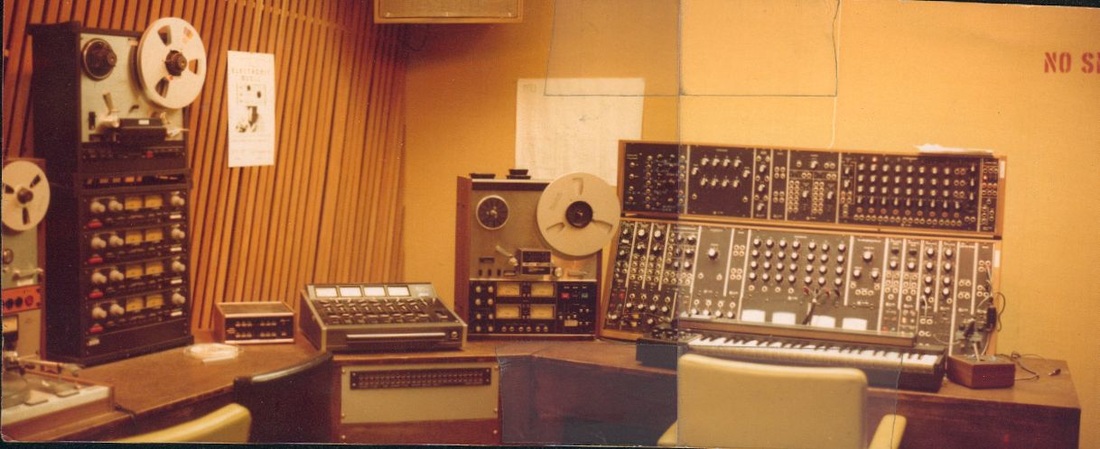Case Study - Electronics Booklet
The Cantata, CASE STUDY, is taken from a newspaper article about a young woman who committed suicide in the 1970s. The article was written in the form of an interview with the woman’s parents. The woman's journal was found in the glove compartment of her car and excerpts from it were intermittently scattered throughout the article. Throughout this entire piece the parents are represented as tape recorded voices who speak from the front two sneakers. The daughter, is represented by the vocal soloist. All seven Arias were composed from the journal entries, and are sung, with the exception of the fifth Aria (which is spoken). Accompaniment is provided by chamber orchestra, percussion ensemble, taped analog electronics, taped voices, dancer, and special lighting.
This webpage shows the "Electronics Booklet" that I created for the CASE STUDY. It originally started out as a patch log... a way to graphically notate the many configurations necessary to make a complex analog synthesizer sound the way you want it to. But it morphed into a multi-page treatise on analog synthesis, and how it related to every recorded sound used in the composition. The Moog synthesizer we had at the Electronic Music Studio at UC Santa Barbara (I believe it was a model IIIc, but expecting correction from Doug Scott any day now), was both a joy and a terror to work with. It used 1/4 inch phone cables to connect the various synthesizer modules. The studio we worked in could get hot because the air conditioning did not always work well, so the synthesizer circuits were prone to drift. That means it would literally take many hours to find exactly the sound you wanted to hear. Of course, the studio had to be shared, so you needed to have a way to capture the patches as much as possible... in case you might have to find that perfect sound once again.
This webpage shows the "Electronics Booklet" that I created for the CASE STUDY. It originally started out as a patch log... a way to graphically notate the many configurations necessary to make a complex analog synthesizer sound the way you want it to. But it morphed into a multi-page treatise on analog synthesis, and how it related to every recorded sound used in the composition. The Moog synthesizer we had at the Electronic Music Studio at UC Santa Barbara (I believe it was a model IIIc, but expecting correction from Doug Scott any day now), was both a joy and a terror to work with. It used 1/4 inch phone cables to connect the various synthesizer modules. The studio we worked in could get hot because the air conditioning did not always work well, so the synthesizer circuits were prone to drift. That means it would literally take many hours to find exactly the sound you wanted to hear. Of course, the studio had to be shared, so you needed to have a way to capture the patches as much as possible... in case you might have to find that perfect sound once again.

This is a picture of the UCSB Electronic Music Studio in 1977-78 where the Moog modular analog synthesizer lived. I've played with a lot of synthesizers before, but there is nothing like the sound of a Moog. It is a lot like flying an old WWII fighter plane... you just have to know what you are doing!
Refer to the patch name/number list to find the time where it occurs in the CASE STUDY MP3 file below, then find the patch in the Electronics Booklet:
|
Patch Name/Number
1a White Noise Introduction 1b Introduction Melody One 1c Introduction Melody Two 1d Introduction Melody Three 1d Introduction Melody Four 2 3 15a 6a, 6b, 6c 7a 7b 8 9c 9a 9b 9d 9a-9d 10a, 10b 11a, 11b, 12a |
Recording Time Index
00:00 - 01:33 01:34 - 02:09 02:10 - 02:41 02:42 - 03:46 03:47 - 04:25 07:29 - 07:43, (Backwards) 12:37 - 12:50 07:44 - 08:30, (Backwards) 11:45 - 12:31 08:46 - 09:35, (Backwards) 09:55 - 10:19 10:21 - 11:44 13:31 - 13:38 13:38 - 13:41 13:43 - 14:04 16:49 - 17:11 17:06 - 17:11 17:19 - 17:28 17:34 - 17:42 17:42 - 18:42 25:08 - 28:10 38:02 - 41:26 |
Electronics Booklet Page Number
12 13 14 15 16 17 18 19 20 - 22 23 23 24 26 25 26 26 25 - 26 27 - 28 29 - 30 |
